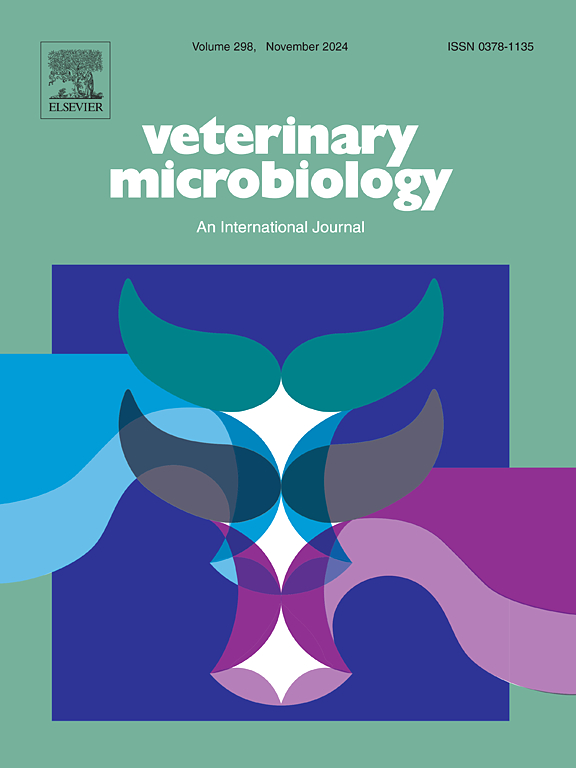vp4特异性IgA水平与猪轮状病毒感染中和抗体和粪便脱落的相关性
IF 2.4
2区 农林科学
Q3 MICROBIOLOGY
引用次数: 0
摘要
轮状病毒(RV)在全球范围内引起儿童、婴儿和幼畜腹泻,具有公共卫生影响。猪轮状病毒(PoRV)导致养猪业的经济损失。中和抗体(NAb)对保护仔猪免受肠道感染至关重要。然而,哪些血清和粘膜标记物与针对PoRV的nab相关,以及与感染后粪便排出相关,这对于病原体特异性检测至关重要,目前尚不清楚。采用间接ELISA法检测猪康复后血清中IgG/IgA、初乳和腹泻仔猪粪便中sIgA对VP4*、VP7*、VP6和NSP4*的抗体水平。分析显示特异性IgA/sIgA水平与NAb滴度的相关性强于IgG。其中,VP4*特异性IgA/sIgA与血清(R = 0.848, P <; 0.0001)和初乳(R = 0.865, P <; 0.0001)NAb滴度呈正相关最高。血清(R= - 0.446, P <; 0.001)和粪便(R= - 0.497, P <; 0.0001)中VP4*特异性IgA/sIgA与病毒RNA载量呈最强负相关。仔猪被动保护试验证实VP4*特异性IgA具有较高的中和能力,与NAb滴度高度相关(R = 0.858, P <; 0.0001),可减少病毒的脱落。总之,黏膜IgA/sIgA对VP4的反应对PoRV诊断和疫苗疗效评价具有重要意义。本文章由计算机程序翻译,如有差异,请以英文原文为准。
VP4-Specific IgA level as a correlate of neutralizing antibody and fecal shedding of porcine rotavirus infection
Rotavirus (RV) causes diarrhea in children, infants, and young animals globally, with public health implications. Porcine rotavirus (PoRV) leads to economic losses in swine farming. Neutralizing antibodies (NAb) are vital for protecting piglets from intestinal infections. However, which serum and mucosal markers correlate with NAbs against PoRV and relate to post-infection fecal shedding remains unclear, crucial for pathogen-specific detection. We used indirect ELISA to measure IgG/IgA in sera, sIgA in colostrum from recovered pigs, and feces from diarrheal piglets against VP4*, VP7*, VP6, and NSP4*. Analyses showed specific IgA/sIgA levels correlated better with NAb titers than IgG. Among them, VP4*-specific IgA/sIgA had the highest positive correlation with NAb titers in sera (R = 0.848, P < 0.0001) and colostrum (R = 0.865, P < 0.0001). Also, VP4*-specific IgA/sIgA in sera (R= −0.446, P < 0.001) and feces (R= −0.497, P < 0.0001) had the strongest inverse relationship with viral RNA load. Piglet passive protection tests confirmed VP4*-specific IgA's high neutralizing capacity, highly correlated with NAb titers (R = 0.858, P < 0.0001), reducing viral shedding. In conclusion, mucosal IgA/sIgA responses to VP4 are important for PoRV diagnosis assays and vaccine efficacy evaluation.
求助全文
通过发布文献求助,成功后即可免费获取论文全文。
去求助
来源期刊

Veterinary microbiology
农林科学-兽医学
CiteScore
5.90
自引率
6.10%
发文量
221
审稿时长
52 days
期刊介绍:
Veterinary Microbiology is concerned with microbial (bacterial, fungal, viral) diseases of domesticated vertebrate animals (livestock, companion animals, fur-bearing animals, game, poultry, fish) that supply food, other useful products or companionship. In addition, Microbial diseases of wild animals living in captivity, or as members of the feral fauna will also be considered if the infections are of interest because of their interrelation with humans (zoonoses) and/or domestic animals. Studies of antimicrobial resistance are also included, provided that the results represent a substantial advance in knowledge. Authors are strongly encouraged to read - prior to submission - the Editorials (''Scope or cope'' and ''Scope or cope II'') published previously in the journal. The Editors reserve the right to suggest submission to another journal for those papers which they feel would be more appropriate for consideration by that journal.
Original research papers of high quality and novelty on aspects of control, host response, molecular biology, pathogenesis, prevention, and treatment of microbial diseases of animals are published. Papers dealing primarily with immunology, epidemiology, molecular biology and antiviral or microbial agents will only be considered if they demonstrate a clear impact on a disease. Papers focusing solely on diagnostic techniques (such as another PCR protocol or ELISA) will not be published - focus should be on a microorganism and not on a particular technique. Papers only reporting microbial sequences, transcriptomics data, or proteomics data will not be considered unless the results represent a substantial advance in knowledge.
Drug trial papers will be considered if they have general application or significance. Papers on the identification of microorganisms will also be considered, but detailed taxonomic studies do not fall within the scope of the journal. Case reports will not be published, unless they have general application or contain novel aspects. Papers of geographically limited interest, which repeat what had been established elsewhere will not be considered. The readership of the journal is global.
 求助内容:
求助内容: 应助结果提醒方式:
应助结果提醒方式:


